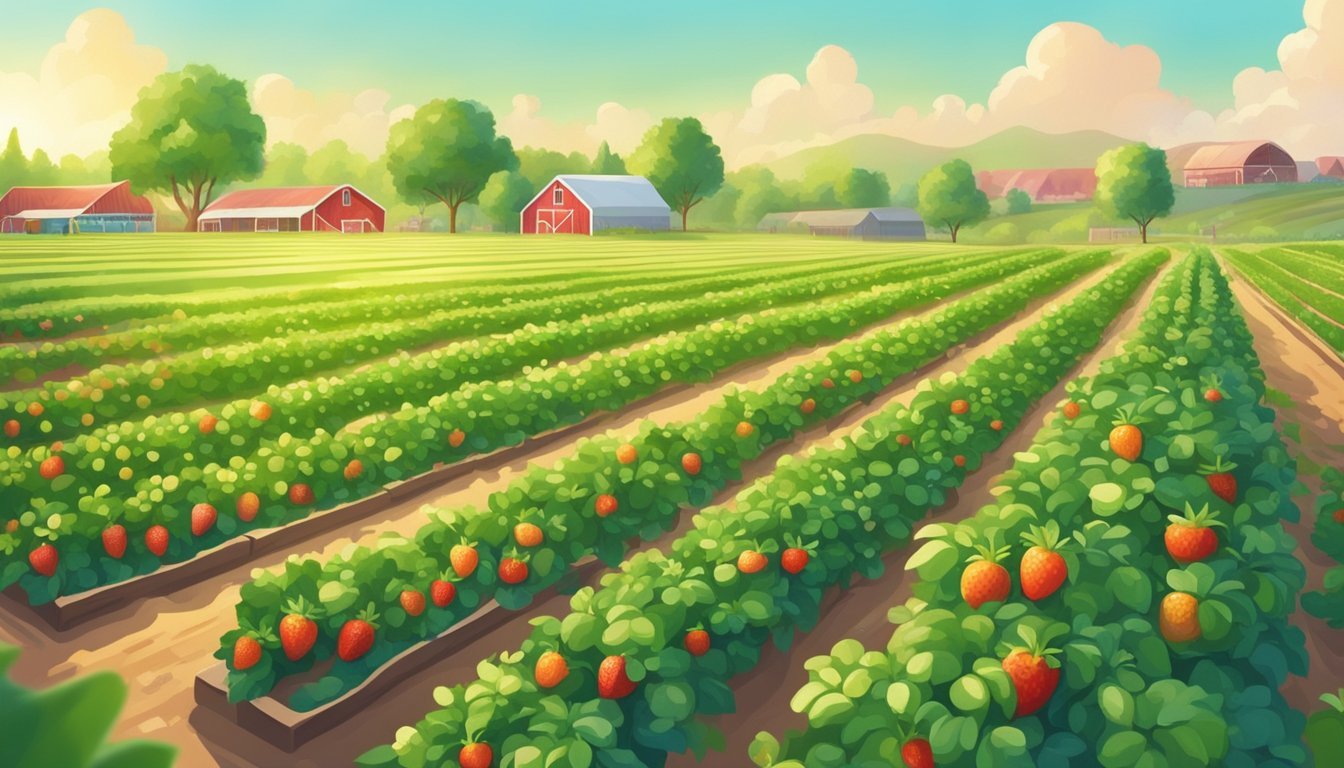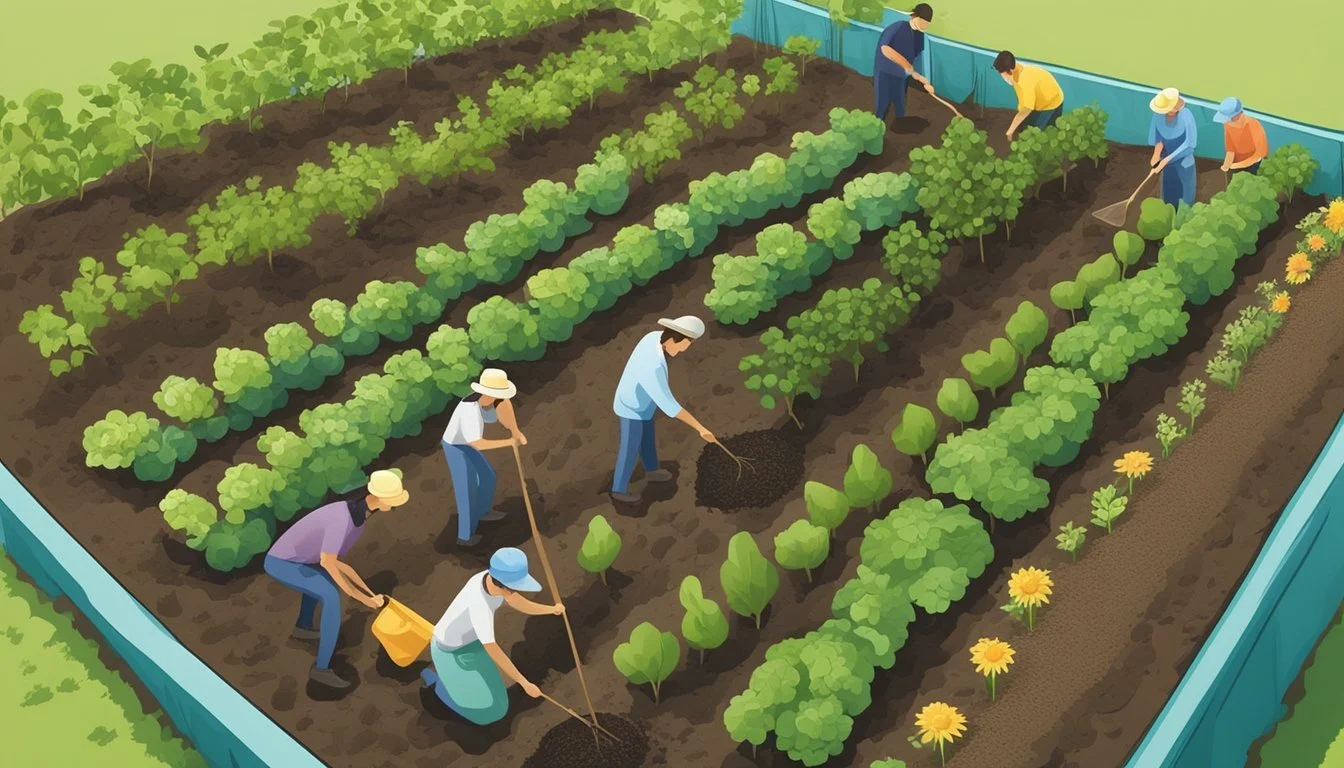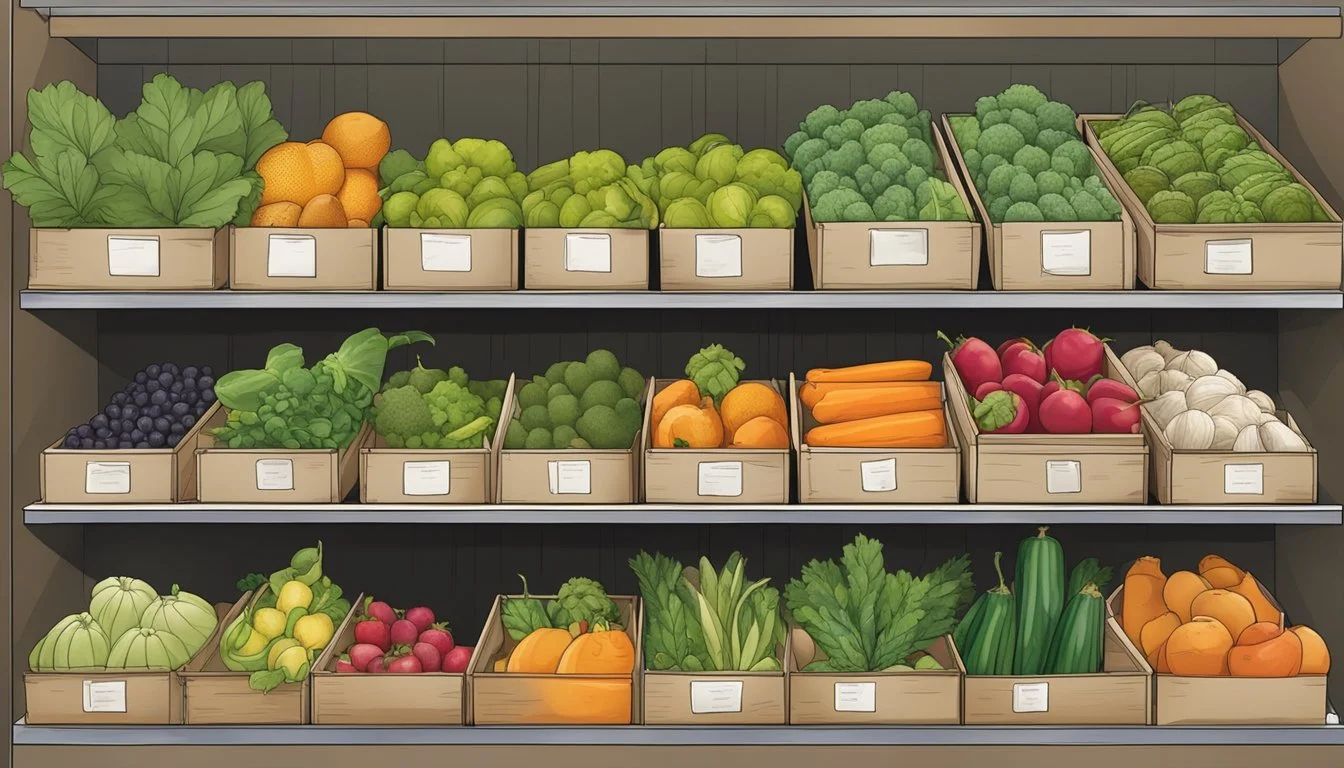New Hampshire Seasonal Fruit & Vegetables in May
Your Fresh Guide
This Article is Part of our New Hampshire Seasonal Fruit & Veg Calendar
As spring unfolds, the landscapes of New Hampshire burst with new growth, signaling a time of renewal and abundance in local agriculture. The month of May marks a significant transition in the state's farming calendar, where an array of fruits and vegetables begin to emerge from the fertile soil. The typically cool and temperate climate of the region supports a diverse range of produce that starts to become available during this period.
Among the first to grace the markets and gardens are leafy greens such as arugula, which remain available through September, and the sturdy stalks of asparagus (What wine goes well with asparagus?), which have a shorter season ending in June. Chard, another versatile green, starts its season in May, offering a continuity that lasts until the brink of winter. These greens are accompanied by the tender and subtly flavored fava beans, (how long do fava beans last?) a springtime favorite that shares the May to June timeframe with asparagus. Green onions, or scallions, add their sharp, fresh flavor to the mix, with a season extending through September, and lettuce varieties begin to offer their crisp textures, continuing well into October.
In addition to the heralds of spring vegetables, fruits also start to hint at their coming seasons. While May is still early for the majority of fruit harvests in New Hampshire, the groundwork is laid for the bountiful months ahead. Orchards and berry farms are preparing for the influx of summer fruits, with blueberries ripening in the late spring warmth, poised to reach their peak between May and July. The anticipation of the fresh, locally grown produce is palpable among those who appreciate New Hampshire's seasonal offerings.
Understanding New Hampshire's Growing Season
In May, New Hampshire's growing season is in a progressive transition. As spring advances, the frost dates become crucial to understanding when to start planting. Generally, in New Hampshire, the last spring frost occurs by late April to mid-May, but this can vary depending on specific locations within the state.
USDA Hardiness Zones play a key role in determining the planting schedules. Most of New Hampshire falls within Zone 5 or Zone 6, which indicates the types of plants that can thrive in the local climate conditions. Farmers and gardeners in New Hampshire must keep a close eye on the weather forecasts to protect tender plants from late cold snaps that can occur in spring.
The typical growing season is relatively short due to the cold climate, and as such, growers make the most of the warmer days that May brings. The soil begins to warm, which is favorable for planting a variety of crops.
Average Spring Planting Dates for Zone 5 & 6:
Cold hardy vegetables: as early as April
Tender crops: after the last frost date
May is often seen as a safe month to begin planting frost-sensitive plants. However, for the best chances of a successful harvest, it is recommended to monitor local frost dates and adjust planting times accordingly.
Different regions within New Hampshire might experience slightly disparate growing conditions due to microclimates, therefore, local knowledge and past experiences are invaluable for understanding New Hampshire's growing season.
Fruits and Vegetables Available in May
In New Hampshire, the month of May marks a transitional period in the agricultural calendar, bridging late spring and the cusp of summer, which influences the variety of produce available. At this time, local farms and gardens begin harvesting several early-season crops.
Vegetables: The cool yet temperate climate of May allows for the cultivation and harvest of a range of vegetables. Amongst these, leafy greens like spinach and lettuce are prime for picking. Root vegetables such as radishes and turnips also reach maturity and can be found fresh in the market.
Fruit: While May is relatively early for the fruit season, some hardy varieties make their way to the consumer. Rhubarb, often used as a fruit in culinary practices, is typically ready for harvest, contributing a tart flavor to seasonal recipes.
Local farmers' markets and co-operatives may display the following available produce:
Vegetables Fruit Spinach Rhubarb Lettuce Radishes Turnips
One should note that the exact availability of produce can fluctuate based on factors such as specific regional climates and the year's weather patterns. Consumers looking for the freshest local produce in May are encouraged to seek out these items, which typically offer a blend of taste and nutrition while supporting local agriculture.
Key Harvest Dates in May
During May in New Hampshire, a variety of fruits and vegetables reach their peak harvest time. The region's seasonal shifts permit an array of crops to be gathered, each at their most flavorful and nutritious state. The following list highlights key crops and their respective harvest dates in May:
Strawberries: Begin to ripen towards the end of May, signaling the start of the berry season.
Asparagus: Peaks in early May, offering tender and fresh spears.
Salad Greens: Including spinach and lettuce, are harvested throughout May, ensuring crisp and vibrant offerings.
Rhubarb: Typically ready for harvest in mid-May, it’s often used in pies and jams.
Green Onions: Also known as scallions, are typically harvested in late May.
It is important to note that these dates can vary depending on weather conditions and specific regional climate factors. Consumers often look forward to the month of May to access the freshest produce directly from local farms. The transition from spring to summer brings an increase in both temperature and daylight, which aids in the maturation of crops. New Hampshire's May harvest sets the stage for a season of abundant fresh produce, signifying a time for locals and visitors to enjoy the flavors of the region.
Benefits of Eating Locally and Seasonally
When individuals choose local produce, they are often selecting foods that are at their nutritional peak. In New Hampshire during May, this means accessing fruits and vegetables that have had the chance to ripen fully before harvest, leading to higher concentrations of key nutrients such as:
Vitamins: Especially C and A
Minerals: Including potassium, magnesium, and phosphorus
Antioxidants: Crucial for combating oxidative stress
Local produce is typically fresher, as it journeys shorter distances to reach the consumer. This not only preserves nutritional quality but also supports the local economy by keeping purchases within the community.
Fresher More Nutritious Community Support Shorter transport time Higher nutrient concentrations Economic benefits to local farmers Less spoilage More antioxidants Reinforcement of local job market
Seasonal eating introduces a variety to one's diet, which is instrumental in providing different nutrients throughout the year, this diversification helps enhance overall health. It can also encourage people to try new recipes and appreciate the natural food cycle.
Variety in Diet: Eating what is in season supports a diverse intake of produce.
Culinary Exploration: New fruits and vegetables can inspire innovative meal ideas.
Furthermore, local and seasonal consumption reduces the carbon footprint, resulting in ecological benefits due to less transportation and storage, contributing to a more sustainable food system.
Spring Vegetables to Look For
As spring arrives in New Hampshire, local markets begin to offer a rich variety of vegetables that are both flavorful and nutritious. This selection especially includes leafy greens, herbs, and several types of cruciferous and root vegetables.
Leafy Greens and Herbs
May sees a variety of leafy greens and herbs flourishing in New Hampshire. Gardeners and shoppers can expect to find:
Kale: A hardy green that's versatile in the kitchen.
Lettuce: Includes a range of types such as Butterhead and Loose Leaf.
Herbs: Fresh herbs like basil begin to make an appearance.
Root Vegetables
Root vegetables remain a staple during the spring months with their earthy flavors and satisfying textures. Look for:
Radishes: These provide a peppery kick to salads and dishes.
Carrots: Carrots are sweet and can be consumed raw or cooked.
Beets: Look for their deep red color and sweet, earthy taste.
Parsnips: A sweeter alternative to carrots, usually cream-colored.
Cruciferous Vegetables
Known for their health benefits, cruciferous vegetables start coming into season:
Cabbage: It's versatile and can be eaten raw or cooked.
Broccoli: This green vegetable is high in vitamins C and K.
Brussels Sprouts: Small in size but packed with flavor and nutrients when they are in season.
Spring Fruits to Enjoy
In May, New Hampshire offers a delectable selection of spring fruits, providing a fresh and flavorful bounty after the winter months.
Berry Varieties
Strawberries and blueberries are the main berry attractions in May. The strawberry season begins, and one can relish the sweet, aromatic red berries that are versatile in use, from fresh salads to desserts. Blueberries are set to follow, hinting at the summer abundance that lies ahead.
Berry Type Harvest Season Start Flavor Profile Popular Use Strawberries Late May Sweet, fragrant Pies, jams, fresh eating Blueberries Approaching June Sweet to tangy Muffins, salads, sauces
Early Stone Fruits
While stone fruits are often more associated with summer, some varieties of cherries start becoming available by the end of May. They offer a range from sweet to tart flavors and can be enjoyed fresh or as a part of many culinary dishes.
Stone Fruit Expected Availability Flavor Profile Suggested Use Cherries Late May Sweet to tart Pies, snacking
May's fruit selection is a preview of the bountiful harvests that New Hampshire proudly offers as the seasons progress.
Planting and Gardening Tips for May
May in New Hampshire is a prime time for garden enthusiasts to start planting a variety of fruits and vegetables. The soil begins to warm, making it suitable for sowing seeds and setting transplants.
Frost-sensitive Plants: It's important to note that tender crops such as cucumbers, pumpkins, squash, and melons perform well when sown directly into the garden in May. To accelerate germination and protect these warmth-loving plants, gardeners should consider using hot caps or cloches to warm the soil a week before planting.
Frost-Sensitive Vegetables Suggested Planting Method Cucumbers Direct sow with soil-warming protections Pumpkins Direct sow with soil-warming protections Squash Direct sow with soil-warming protections Melons Direct sow with soil-warming protections
For plants started indoors as seedlings, as May advances, they should be gradually introduced to outdoor conditions—a process known as hardening off.
Hardening Off: Begin this process by placing transplants outside in a shaded, protected spot for a few hours each day, gradually increasing their exposure to sunlight and outdoor temperatures.
Additionally, growers need to be mindful of their region’s hardiness zone. New Hampshire generally falls within zone 5 or 6; planting times may need to be adjusted according to specific local conditions.
Lastly, consistent watering and monitoring for pests will ensure that the plants establish themselves well in the garden. Regular maintenance and vigilance in the spring pay off with robust growth as the season progresses.
Maintaining a Healthy Garden
In May, as gardeners in New Hampshire prepare their gardens for the upcoming harvest season, attention to maintenance is crucial for cultivating robust fruits and vegetables. Here are several tips for sustaining a healthy garden during this time of year.
Soil Preparation: They should ensure the soil is warm and the risk of frost has passed before planting sensitive crops like tomatoes and peppers. Consistently maintaining soil temperature above 50°F at night is vital.
Pest Control: Effective pest management involves regular observation. Gardeners should monitor for common pests and diseases, resorting to organic or chemical treatments only as needed. Installing physical barriers like nets or row covers can also protect sensitive crops without using pesticides.
Watering: They must provide consistent watering, especially during dry spells. Vegetables require an inch of water per week, whether from rainfall or direct watering. Mulching can help in retaining soil moisture and regulating soil temperature.
Greenhouse Maintenance: For those using a greenhouse, maintaining proper ventilation and controlling humidity levels is critical to avoid issues like mold and mildew, which can be detrimental to young plants.
Garden Task Description Soil Preparation Warm the soil, ensure frost-free conditions, and maintain night temperature. Pest Control Monitor regularly, use treatments sparingly, and consider physical barriers. Watering Schedule Aim for at least one inch of water per week, either from rain or watering. Greenhouse Regulation Monitor ventilation and humidity to protect plants from mold and mildew.
By following these maintenance practices, gardeners can create an environment that supports the growth of healthy seasonal fruits and vegetables throughout the month of May.
Exploring Local Farmers Markets
May is a robust month for local produce in New Hampshire, making it an ideal time for food enthusiasts and health-conscious consumers to explore the array of offerings at local farmers markets. These markets serve as gateways to seasonal fruits and vegetables, freshly picked from the farms of the Granite State.
Farmers Markets in New Hampshire boast an intimate connection with the seasons, ensuring that visitors can enjoy a variety of fresh produce. May brings a selection of early harvests to the market stalls, such as:
Greens: Spinach, lettuces, and kale
Vegetables: Radishes, green onions, and asparagus
Herbs: Chives, cilantro, and parsley
The experience is not limited to produce alone. Local artisans and farmers often offer homemade goods like breads, cheeses, and preserves, giving a full spectrum of what the state's soil and hands can produce.
Seasonal Availability:
Product Availability Spinach Early May Asparagus Mid to Late May Rhubarb Late May
Shoppers at these markets support the local economy and have the unique opportunity to meet the farmers and growers, gaining insights into where and how their food is grown. Locations vary from small roadside setups to larger, organized markets in town centers.
The Concord Farmers Market is an example of a larger venue that operates on Saturdays from 8:30 a.m. to 12 p.m. It's a place where the community gathers not just to shop, but to enjoy a sociable environment rich with New Hampshire's seasonal bounty.
Preservation and Storage of May Produce
In May, New Hampshire gardens begin to yield a variety of fresh produce. Proper preservation and storage methods are essential to extend the freshness of these crops. Here is a concise guide to ensuring that May's bounty lasts.
Refrigeration: Most leafy greens like lettuce, arugula, and spinach should be stored in the refrigerator to maintain crispness. They can be wrapped in a damp paper towel and placed in a plastic bag to retain moisture. Herbs like mint and parsley benefit from being kept in a jar with water, much like cut flowers, and covered loosely with a plastic bag.
Root Vegetables: Radishes, should be separated from their greens to prevent moisture loss, and stored in the crisper drawer of the refrigerator.
Asparagus: Keep it upright in a container with an inch of water or wrap the ends with a wet paper towel and bag them.
Crop Preservation Method Storage Location Duration Lettuce Damp paper towel in plastic bag Refrigerator Up to 1 week Arugula Damp paper towel in plastic bag Refrigerator 2-5 days Spinach Airtight container with towel Refrigerator Up to 1 week Mint In water, covered with bag Refrigerator Up to 2 weeks Parsley In water, covered with bag Refrigerator 1-2 weeks Radishes Separate greens, plastic bag Refrigerator 1-2 weeks Asparagus Upright in water or damp towel Refrigerator 3-5 days
Dry Storage: Fava beans are best kept in a cool, dry place and can be stored in the refrigerator as well.
For longer-term preservation, many May vegetables can be blanched and frozen. This process involves briefly boiling the vegetables, then shocking them in ice water to halt cooking, and sealing them in airtight containers or bags before freezing. This method retains the flavor and nutrients and allows one to enjoy the harvest for months to come.












